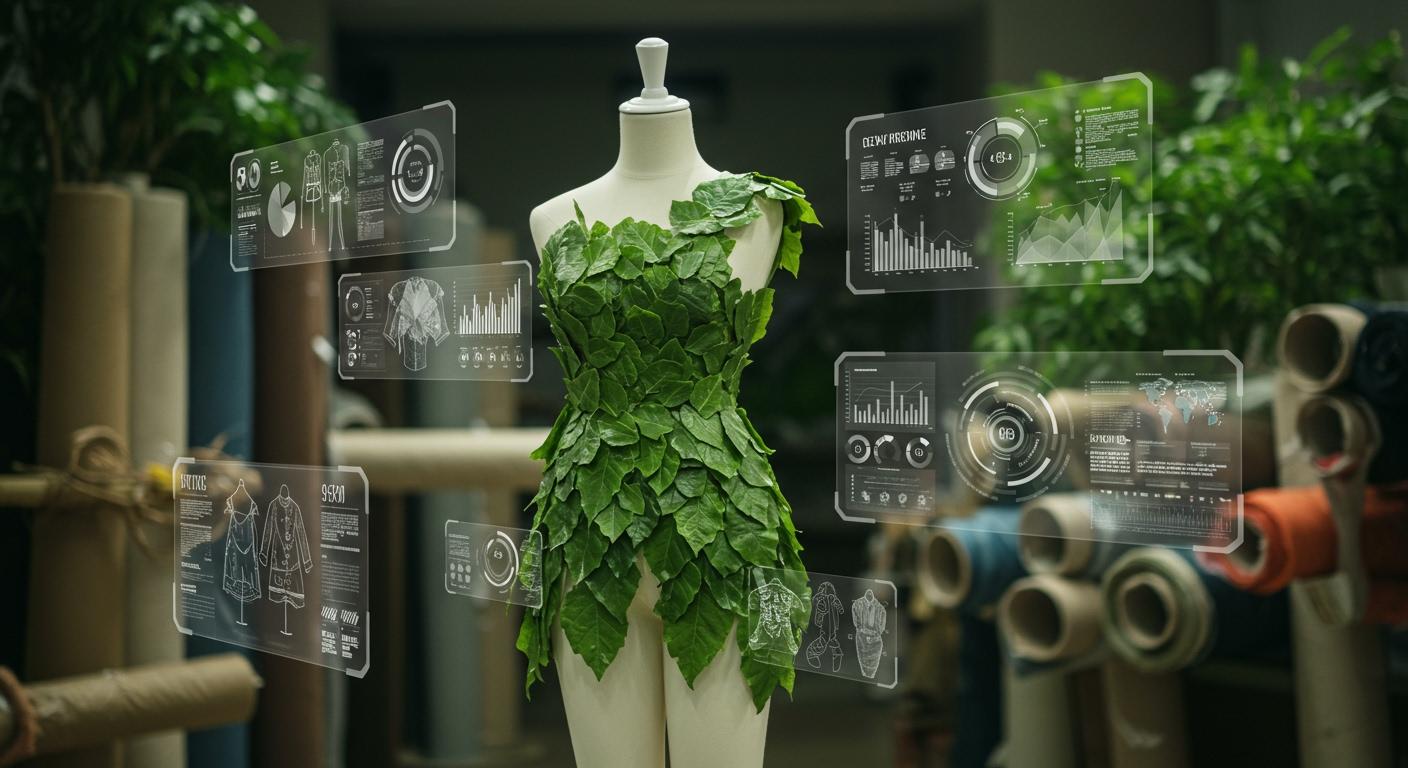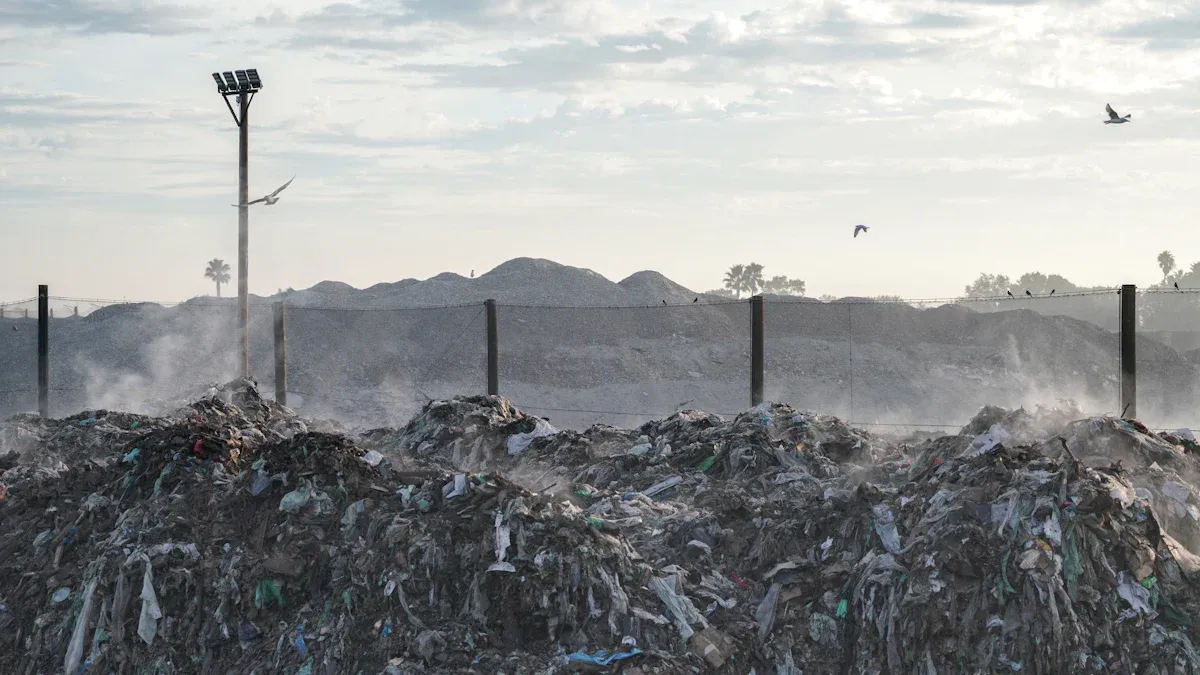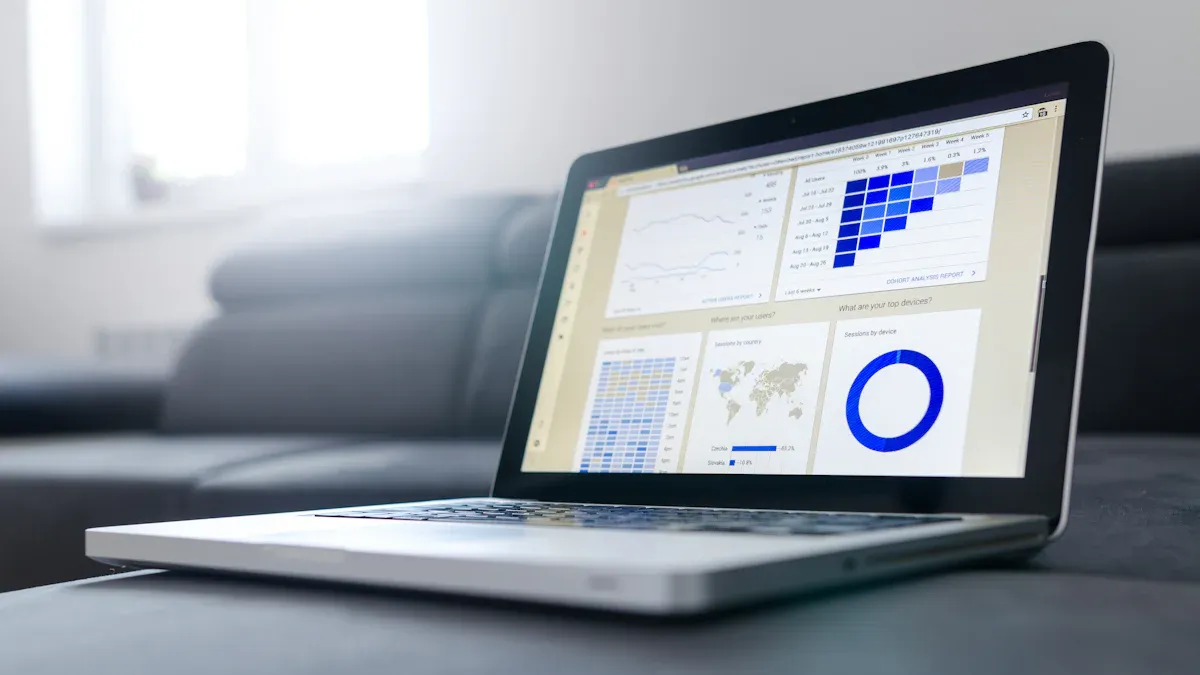
The fashion industry faces a significant environmental challenge. Globally, 92 million tons of textile waste are generated each year. This massive waste problem demands a new approach. Predictive analytics offers a powerful solution for textile waste reduction. It transforms waste management from a reactive process into proactive resource optimization.
Predictive analytics enables a true circular economy. It provides the data needed for effective recycling and waste reduction. This shift toward circularity helps reduce the industry's environmental impact. With only 1% of post-consumer textile waste recycled into new clothing, predictive analytics is key to improving sustainability and achieving circular goals. This technology supports waste reduction and better textile recycling.
The Current Waste Landscape

The fashion industry's current model generates an unsustainable amount of textile waste. Understanding this landscape is the first step toward building circular systems. Predictive analytics offers powerful strategies for this transformation, enabling effective textile waste reduction and better waste management practices.
The Scale of the Waste Crisis
The volume of textile waste has reached a critical point. The global and regional figures highlight the urgency for better waste reduction strategies and improved recycling systems.
| Category | Annual Textile Waste (Million Tonnes) |
|---|---|
| Global | 92 |
| European Union | 12.6 |
This massive amount of waste has a severe environmental impact. When textile waste decomposes in landfills, it releases methane, a greenhouse gas far more potent than carbon dioxide. This process contributes to climate change. Additionally, dyes and chemicals from the textile leach into the soil and groundwater. This pollution harms ecosystems and threatens water sources, showing the deep environmental cost of inaction. These environmental issues demand new circular practices.
From Reactive to Proactive
Predictive analytics helps the industry shift from reactive waste management to proactive resource optimization. A reactive approach deals with textile waste after it is created. A proactive approach, powered by predictive analytics, prevents waste from being generated. This involves several key practices.
Companies can enhance supply chain visibility and optimize inventory. These practices ensure that production matches demand, which is a core principle of textile waste reduction. This shift supports sustainability goals and builds more resilient circular business models. Predictive analytics makes these proactive initiatives possible.
Key Data Sources
Effective predictive analytics relies on diverse data streams. These systems analyze information from multiple points in the textile lifecycle to forecast trends and optimize processes for textile waste reduction. Key sources include:
- Consumer Data: Historical sales data, purchasing patterns, and social media trends provide insights into what customers want. Predictive analytics uses this information to guide production decisions.
- Production Data: Information on material usage and manufacturing efficiency helps identify areas for reduction and optimization.
- Waste Collection Data: Data from textile recycling facilities on fiber composition and textile type helps improve sorting for recycling. This information is vital for creating a circular textile economy and improving textile waste diversion.
Hurdles to a Circular System
Implementing a fully circular economy faces significant hurdles. The industry lacks the specialized technologies needed for efficient textile recycling and material separation. Existing systems were built for a linear, not a circular, model. This makes large-scale recycling and diversion practices difficult.
Furthermore, data presents a major challenge. There is no standardized method for collecting data on textile waste. This lack of quality data hinders the effectiveness of predictive analytics and slows the adoption of circular business models. Overcoming these technological and logistical barriers is essential for achieving true environmental sustainability and textile waste diversion. These challenges slow down circular initiatives and the broader adoption of sustainable practices.
The High Cost of Inaction
Failing to address the textile waste crisis carries severe consequences. The current linear model is unsustainable, creating escalating environmental, economic, and social problems. Inaction locks the industry into damaging practices and prevents the transition to a circular economy. Better waste management is not just an option; it is a necessity for future sustainability.
Worsening Environmental Impact
Continuing current practices will worsen the industry's environmental impact. The fashion sector's carbon emissions could soar to 26% of the global total by 2050. This environmental damage stems directly from massive textile waste.
Every second, a garbage truck's worth of clothing is burned or landfilled. Synthetic textiles, like polyester, can take centuries to decompose. During this time, they break down into microplastics, polluting soil and oceans. This ongoing waste generation creates a significant environmental burden, making textile waste reduction a critical goal.
Economic Stagnation
The current system creates enormous economic waste. Brands lose over $100 billion in material value annually because less than 1% of textile material is recycled into new clothing. This financial drain is a direct result of flawed production practices. Many brands intentionally overproduce, fearing they might miss out on sales. This strategy, driven by an archaic manufacturing system that rewards volume, leads to massive amounts of unsold inventory. These outdated practices prevent the industry from adopting more profitable and circular business models, hindering progress toward sustainability and effective textile waste reduction.
Social Consequences
The social cost of textile waste is profound. Landfills and incinerators are often located in low-income and minority communities. These residents face disproportionate exposure to harmful air emissions and other environmental hazards. The problem extends globally, as a large portion of textile waste is shipped to countries with less advanced waste management systems. This practice exports the environmental burden. Furthermore, the demand for cheap, fast fashion drives poor labor conditions in garment-producing nations. This cycle of waste perpetuates exploitation and undermines global sustainability efforts, showing the urgent need for circular practices and responsible reduction of textile waste.
Predictive Analytics for Sustainability

Predictive analytics offers a clear roadmap for transforming the fashion industry's wasteful habits into sustainable practices. This technology provides the tools to build a truly circular economy. It moves the industry beyond theory and into actionable strategies for textile waste reduction. These data-driven initiatives create powerful environmental and economic benefits. The adoption of these systems is crucial for long-term sustainability.
Optimizing Collection for Recycling
Efficient collection is the first step toward effective textile recycling. Predictive analytics revolutionizes this process. It optimizes collection routes and schedules for textile waste. This optimization reduces costs and the environmental impact of transportation. Waste management systems become smarter and more responsive.
A study in Spain’s Huesca region showed the power of these strategies. Dynamic route planning with sensor technology improved resource allocation for textile waste collection. This approach cut travel costs and reduced environmental harm. Another case study highlighted even more specific gains from sensor-based systems.
A sensor-enhanced dynamic collection system for discarded textile waste led to a 7.4% reduction in collection costs. It also improved time efficiency by 7.3% and lowered CO2 emissions by 10.2%. These numbers show how predictive analytics creates tangible improvements in recycling logistics.
These practices ensure a steady, clean stream of material for recycling systems. Better collection is fundamental for textile waste diversion and supports a circular textile economy. This is a key part of effective waste management.
Forecasting for Textile Waste Reduction
The biggest opportunity for textile waste reduction lies in preventing its creation. Predictive analytics gives brands the power to align production with actual demand. This forecasting minimizes overproduction, a primary source of waste. Brands can shift from guessing what consumers want to knowing what they will buy. This change is vital for sustainable practices.
Advanced algorithms analyze vast datasets to make accurate predictions. These systems identify the type and volume of future post-consumer textile waste.
- Deep learning algorithms like Convolutional Neural Networks (CNNs) classify textile samples using Near-Infrared (NIR) spectra. This method supports automatic sorting for large-scale recycling.
- Other algorithms, including PCA, SVM, and PLS, help identify fiber types and components from various data sources.
Brands like Zara and Nike already use predictive analytics to manage their operations. They forecast demand to optimize inventory and adjust production. This practice reduces waste and ensures timely delivery. Companies can use predictive analytics in several ways for textile waste reduction:
- Analyze Past Performance: Use historical sales data to understand seasonal trends and inform future production.
- Leverage Real-Time Data: Track market trends and competitor assortments to adjust product mixes.
- Use Consumer Sentiment: Analyze reviews and social media to anticipate shifts in preference.
- Test with Smaller Batches: Launch limited runs of new designs to gauge interest before committing to large-scale production.
- Integrate External Signals: Incorporate factors like weather patterns and cultural events to improve forecast accuracy.
These strategies lead to a significant reduction in unsold inventory. This is a core component of textile waste diversion and circular business models.
Enabling a Circular Economy
Predictive analytics is the engine of a circular economy. It enables new business models that extend the life of garments and materials. These circular initiatives depend on data for success. Rental, resale, and repair services thrive on understanding an item's lifecycle, demand, and condition. Predictive analytics provides these critical insights.
For example, predictive models help rental platforms optimize their inventory. AI-driven recommendation engines suggest suitable options to customers. This increases satisfaction and conversion rates. McKinsey reports that fashion companies using AI for inventory management see inventory costs fall by 20-50%. Predictive analytics also helps designers create products less likely to be returned, which is a direct form of waste reduction. These circular practices create new revenue streams from existing textile products.
Furthermore, predictive analytics ensures the smooth operation of recycling systems. In industrial recycling, companies use predictive maintenance to prevent equipment downtime. This same principle applies to textile recycling machinery. It keeps the circular systems running, avoiding stoppages that disrupt the flow of materials. This optimization is essential for closing the loop. Predictive analytics matches recycled materials with manufacturing needs in real-time, creating a truly circular flow of textile resources and supporting textile waste diversion. These circular business models are key to long-term sustainability.
Policy and Collaboration
Technology alone cannot create a circular economy. Meaningful change requires supportive policies and industry-wide collaboration. Predictive analytics provides the data needed to design effective policies. Lawmakers can use insights on waste generation and material flows to develop smart regulations, such as Extended Producer Responsibility (EPR) schemes. These data-driven policies encourage brands to design for circularity and take responsibility for their products' end-of-life.
Collaboration is equally important. The industry needs shared data platforms to achieve true circularity. When brands, collectors, and recyclers share information, the entire system becomes more efficient. Predictive analytics can power these platforms, creating a transparent and connected textile ecosystem. These collaborative initiatives help standardize data collection, a major hurdle for current recycling efforts. This shared intelligence accelerates the transition to sustainable practices and a fully circular economy. It fosters an environment where waste is a resource, not a problem.
The fashion industry stands at a crossroads. One path leads to overflowing landfills and continued environmental damage from textile waste. The other path, guided by predictive analytics, ascends toward a resource-efficient circular economy. The choice depends on the actions taken today to advance sustainability. These circular initiatives require new practices and systems for effective textile waste reduction.
Stakeholders can drive this change through several key actions:
- Invest in Data Infrastructure: Build robust data management systems to collect and analyze information, enabling better decision-making for textile waste reduction.
- Champion Data-Sharing Pacts: Promote industry-wide collaboration to harmonize data requests and improve the efficiency of recycling systems.
- Advocate for Supportive Policies: Support Extended Producer Responsibility (EPR) policies that hold producers financially responsible for post-consumer textile waste.
- Engage Consumers in Circularity: Encourage responsible consumption and participation in circular practices like take-back programs.
Predictive analytics powers these circular initiatives, turning textile waste into a resource. This transformation supports a circular textile economy and long-term environmental sustainability. The reduction of waste through these practices is critical.
This journey toward a circular economy raises important questions. How can the industry ensure data governance is both ethical and effective? What role should consumers play in providing the data needed for truly circular systems and responsible consumption?
FAQ
What is predictive analytics in fashion?
Predictive analytics uses data to forecast future trends. In fashion, it helps brands understand consumer demand. This technology provides insights to reduce textile waste and improve production decisions. Predictive analytics is a key tool for managing textile waste.
How does predictive analytics reduce textile waste?
Predictive analytics helps brands match production with real demand. This practice minimizes overproduction, a huge source of textile waste. Companies create less unsold inventory. This directly cuts down on textile waste and supports a more sustainable industry. Predictive analytics makes this waste reduction possible.
What data does this technology use?
Predictive analytics analyzes several data types. It uses sales history, social media trends, and even textile waste collection data. This information helps forecast demand and improve textile recycling processes. The goal is to prevent textile waste before it happens.
Can small brands use predictive analytics?
Yes, smaller brands can adopt predictive analytics. Many scalable and affordable tools are now available. These solutions help businesses of all sizes make smarter decisions. They can reduce their textile waste and manage inventory effectively, preventing unnecessary textile waste.
See Also
Optimizing Fashion Inventory: Predictive Analytics for Supply-Demand Equilibrium
Fashion Retail's Future: Predictive Modeling Insights for 2025 Success
Leveraging Sales Data for Precise Fashion Trend Predictions and Forecasts
Revolutionary AI in Fashion: Sustainable Solutions for a Greener Earth
Machine Learning's Role: Forecasting Fashion Trends to Skyrocket Sales